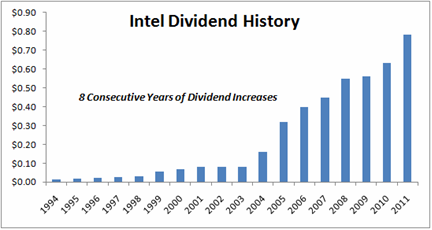With market volatility the order of the day, a growing number of investors are looking for ways to protect against downside risk, and simultaneously generate guaranteed income that trumps currently depressed savings and CD rates. That has market participants taking longer and harder looks at dividend-generating equities like tech heavyweight Intel (INTC).
Before jumping into any stock for its dividend-paying potential, you need to consider a company’s stock price, its business fundamentals, free cash flow, and future prospects. Right now, by almost all of those metrics, Intel is near the top of its dividend game.
In its most recent reporting period, Intel paid a dividend of 63 cents a share. As you can see by the chart below, Intel has grown its dividend year-over-year for eight consecutive years. By comparison other companies in the computer hardware space—including Apple, Dell and AMD—offer no dividend at all.

In fact, Intel has managed to raise its quarterly dividend consistently since 1992, when the company paid out a quarterly dividend of less than 1/3rd of 1 cent. Now the quarterly dividend sits at a cool 21 cents.
Okay. So Intel’s dividend performance has been admirable. But can the company sustain the trend while also maintaining share price stability, making INTC a sensible dividend play? First, let’s take a quick look at INTC’s stock performance.
Although there’s been volatility in INTC’s share price over the past decade, the company has managed to grow earnings per share at an average of 30% a year since 2001. During the same period the stock itself has delivered an annualized total return of 1.40%, and the company has bought back about 2.4% of its outstanding shares.
The flip side to the company’s performance is that the return on equity has decreased and is currently hovering at around the 20% mark after peaking in 2005 at 23%. That figure has been as low as 10.9% in 2009, in the wake of the 2008 meltdown in U.S. financial markets. So, as with any other stock, INTC is vulnerable to market forces, but its share price has generally remained stable over time.
Dividend gurus also look to the “dividend payout ratio” as a key indicator of a company’s ability to sustain its dividend growth. Quite simply, the dividend payout ratio refers to the percentage of a company’s net earnings that it takes to pay out its dividend, so the lower the ratio the better. And because the ratio is pegged to earnings and cash flow, it changes from quarter to quarter.
With Intel logging an increase in free cash flow of 73% this year, from $6.65 billion in 2010 to $11.48 billion in 2011, its payout ratio has dropped to around 30%, and has remained below 50% over the past decade, with the exception of 2008 and 2009.






Add your Comment
use your Google account
or use your BestCashCow account